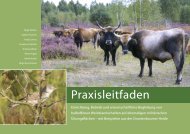TAGUNGSBAND CONFERENCE PROCEEDINGS - Offenlandinfo
TAGUNGSBAND CONFERENCE PROCEEDINGS - Offenlandinfo
TAGUNGSBAND CONFERENCE PROCEEDINGS - Offenlandinfo
Sie wollen auch ein ePaper? Erhöhen Sie die Reichweite Ihrer Titel.
YUMPU macht aus Druck-PDFs automatisch weboptimierte ePaper, die Google liebt.
Semi-natural grassland as a source of<br />
native seed: comparison of different<br />
harvesting methods<br />
Michele Scotton, Claudia Dal Buono, Antonio Timoni<br />
University of Padova, Department of Environmental Agronomy<br />
and Crop Production, Legnaro Podova, Italy<br />
The several methods available to harvest seed from seminatural<br />
grassland differ because of their technical characteristics<br />
(type and cost of necessary equipments and of<br />
harvested material, sites and vegetations which they are<br />
suitable for) and because of their “biological” efficiency<br />
(amount and quality of collected seed).<br />
“High biomass” methods, Harvesting as Green hay and Dry<br />
hay, need equipments usually available in standard agricultural<br />
farms and can be adopted up to relatively high slopes.<br />
The harvesting product is at the same time propagation<br />
and mulching material and is therefore particularly suited<br />
for ecological restoration of deep surfaces to be protected<br />
against erosion. Concerning harvesting efficiency, both<br />
methods have low species selectivity, even if the Green hay<br />
harvesting collects much higher amounts of the standing<br />
seed yield.<br />
“Low biomass” methods as Threshing, Seed stripping<br />
and Vacuum harvesting need specific equipments which,<br />
at least for threshing, can have high costs. The highest<br />
slopes, which they can be used at, change according to the<br />
equipment but, generally, these techniques are less easily<br />
adaptable to difficult site conditions. A disadvantage is that<br />
harvesting efficiency and species selectivity can be very<br />
variable with type of equipment and characteristic of the<br />
standing vegetation.<br />
“Topsoil” methods (topsoil stripping and turfing) have only<br />
to be applied, when destroying of the donor site vegetation<br />
is unavoidable and, due to the high weight of the harvested<br />
material (soil containing seed and plants), are best suited<br />
for situation, where topsoil can be used in situ. They need<br />
specific high cost equipments, but can usually work well<br />
on steep and uneven surfaces. These methods are not<br />
selective, as they harvest everything present in the upper<br />
soil layer. However, in the case of topsoil stripping, the<br />
restoration results can heavily depend on the seed bank,<br />
more than on the standing vegetation.<br />
14<br />
Best-practice methods for the development<br />
of species-rich grasslands:<br />
experiences from the SALVERE project<br />
Anita Kirmer, Katja Eis, Sandra Mann, Sabine Tischew<br />
Anhalt University of Applied Sciences, Department for Nature<br />
Conservation and Landscape Planning, Bernburg, Germany<br />
In Central Europe, species-rich grasslands are highly<br />
endangered by landuse intensification and abandonment.<br />
The protection of genuine, natural grasslands containing<br />
regional sub-species and ecotypes in region-specific<br />
compositions is a top priority in nature conservation. But<br />
nature conservation management is expensive. Therefore,<br />
it is necessary to acknowledge not only the high ecological<br />
and aesthetic values of these sites but also their economical<br />
value as donor sites for valuable seed mixtures. Directly<br />
harvested seed mixtures can be used for restoration and<br />
re-vegetation measures, thus can contribute directly to the<br />
preservation and development of biological diversity in the<br />
concerned region.<br />
Within the SALVERE project, seed mixtures were harvested<br />
in species-rich donor communities (Arrhenatherion, Bromion,<br />
Deschampsion) via mowing, threshing, and brushing.<br />
The harvested material was applied on suitable receptor<br />
sites comprising former arable land, ploughed species-poor<br />
grasslands, and raw soils. Altogether, 17 large-scale trials<br />
were realised in six countries (Austria, Czech Republic,<br />
Germany, Italy, Poland, Slovakia) during summer 2009. First<br />
results showed that transfer rates of donor site species<br />
differ significantly dependent to different receptor sites<br />
as well as restoration methods. For example, transfer of<br />
green hay is more successful on raw soils (62.4 ±17) than on<br />
former arable land (39.1 ±3.9) or disturbed grasslands (31.0<br />
±3.2). After one year, the share of target species on total<br />
coverage strongly depends on the type of harvested donor<br />
site as well as on the type of receptor site. Target species<br />
from Arrhenatherion communities reached a higher coverage<br />
on receptor sites than target species from Bromion<br />
or Deschampsion communities. Receptor sites on raw soil<br />
showed the highest proportion of target species.<br />
Based on the results of the project as well as literature findings,<br />
recommendations for the selection of best practice<br />
methods in grassland restoration under different starting<br />
conditions will be presented.




